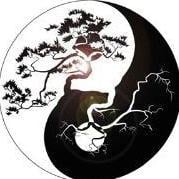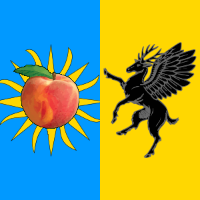-
Posts
3,454 -
Joined
-
Last visited
Profile Information
-
Gender
Male
-
Location
San Diego, Ca.
Previous Fields
-
Name
David
Recent Profile Visitors
AlaskanSandman's Achievements

Council Member (8/8)
-

The Starks are Andals (or "what's in a name?")
AlaskanSandman replied to Tradecraft's topic in General (ASoIaF)
https://en.wikipedia.org/wiki/West_Asia Idk how many sources you need, but here is another clearly showing the Middle East as part of West Asia. Asia Minor is apparently specifically Turkey/Anatolia, but West Asia encompasses Asia Minor and the Middle East. -

The Starks are Andals (or "what's in a name?")
AlaskanSandman replied to Tradecraft's topic in General (ASoIaF)
I don't doubt that there is inspiration from China, I just think there is also strong Phoenician influence. As stated before, China has no connective mythos to Europe, where as the Middle East does. Both are a part of Asia any ways and I wouldn't be surprised if there was Vedic/Indian influence too. I feel the Dothraki def are inspired by the Huns and Mongols. I just think its easier for George to give the feel of Asia by using word more akin to Mandarin rather than Semitic. Its obvious by this thread thus far that some for some reason debate whether the Middle East is even part of Asia, so clearly using some Chinese influence conveys his general idea better. Im quite surprised anyone would honestly even debate the Middle East being part of Asia. Like, they forgot the story of Noah and his sons. Ham got Africa, Japheth got Europe, and Shem got Asia (Some consider America his too since the Natives descend from peoples in China and Russia. Alexander the Great often referred to those lands as Asian also, but what ever. These types of view points obviously affect peoples interpretations of the books and thats ok. This is just my take. I think George is playing with the idea that like the Noah myth, or Iapetus myth, that we are tied by ancestry and so the lines of distinction gets murky when debating whether the Andals are Valyrian, or the Starks are Andals. There is debate on Hightower relations to Valyria and they have more evidence going for them than the Starks. I find some on this forum tend to agree upon ideas, while others disagree. I don't bug out by people disagreeing, though it does make some progress in discussion feel limiting. -

The Starks are Andals (or "what's in a name?")
AlaskanSandman replied to Tradecraft's topic in General (ASoIaF)
Excuse me!?!?!?!?! You might wanna watch what you say to people. Accuse me of some shit like that. You wanna debate the book, cool. You wanna debate the likely hood of people calling brown eyed people "Bright eyed", cool. You call me racist cause I say bright eyes aren't typically thought of as brown, then your way off base and beyondddd offensive. First of all, I have brown eyes and have never been told i have bright eyes. How does eye color even make one racist??? Such a beyond rude thing to say. -

The Starks are Andals (or "what's in a name?")
AlaskanSandman replied to Tradecraft's topic in General (ASoIaF)
Well I wasn't hung up on every detail mirroring, that would be frankly boring. As mentioned above, they're all likely loose inspirations. England never had dragons so far as we know, but there was the war of the Red dragon (Welsh) vs the White Dragon (Anglo-Saxons), plus the Norse rode dragon ships. Plus yea, Sparta was never a city state, it was a Kingdom. Also, lets not forget Alexander the Greats short lived Empire. Its off topic so I dont want to derail from the OP much, but the idea of Yi-Ti being Phoenicia/Lebanon connects it to European/Essosi events and myths. Its from Lebanon that the word Bible comes from, from Byblos where the papyrus paper was made that it was written on. Further, their gods were considered the same, with Baal Hadad being Zeus/ Jupiter/ Tyr (Ziu in Old High German). While Jesus the Morning Star was called Earendel in Christ 1 poem 800Ad, which is Old English for Eosphorus, the Morningstar. Who is likely the inspiration behind Azor Ahai, Bloodstone Emperor who is the 13th member of the Gemstone Empire. Iapetus was linked to Japheth (יֶפֶת) one of the sons of Noah and a progenitor of mankind in biblical accounts. https://en.wikipedia.org/wiki/Iapetus This would make Uranus, the father of the Titan Iapetus, Noah. The 10th generation since Adam and Eve. With the Titan Hyperion being the 11th. His daughter Eos (Eastre/ Easter), being the 12th, while Eosphorus the morning star is the 13th. So my idea is based off a lot of other ideas. (Yes I know Tyrosh is the ones in the books who make purple dye, but the symbolism in purple is in Valyria, who they come from, and even Yi-Ti. Not all inspirations are exact mirrors, but they rhyme.) -

The Starks are Andals (or "what's in a name?")
AlaskanSandman replied to Tradecraft's topic in General (ASoIaF)
But you're the authority on what inspired him, dude? lol You're welcome to think what you want. If you want it to be China, then sure. Its China. Its missing the shore and Ocean but ok They're called "Bright Eyed". Something people in China are not. Where as people in modern day Phoenicia/ Lebanon actually do have "Bright Eyes" as some have blue eyes https://www.quora.com/Why-do-some-people-who-live-in-Syria-and-Lebanon-have-blue-eyes-and-are-as-white-as-Europeans-in-some-cases-even-more-so-Does-this-have-any-connection-with-the-ancient-crusaders https://www.quora.com/How-common-are-blue-green-and-hazel-eyes-in-the-Middle-East https://qph.cf2.quoracdn.net/main-qimg-9be74f4e9472856d0c054fe84a89d0db-lq -

The Starks are Andals (or "what's in a name?")
AlaskanSandman replied to Tradecraft's topic in General (ASoIaF)
Its part of Asia Minor or Western Asia. Ill respond to the rest when I have a lil more time. -

The Starks are Andals (or "what's in a name?")
AlaskanSandman replied to Tradecraft's topic in General (ASoIaF)
It clearly says in TWOIAF that Lann was a possible Andal Adventurer. Garth isn't likely the First men as people in Dorne don't worship him. If he had led the first men, they would likely have worshiped him. Further, its kinda clear from the text that the real first men were House Casterly, and House Manderly. House Hightower is debate-able as First Men or Pre-First Men. If House Gardener was so powerful from the get go, and were there before House Manderly, then the Mander would be named for them, not Garth. Further, House Manderly worships Mermen, not the Greenman. So clearly different waves of people. -

The Starks are Andals (or "what's in a name?")
AlaskanSandman replied to Tradecraft's topic in General (ASoIaF)
No, as across the waters from Rome is Greece, not Phoenicia. The maps are clearly Europe with Britain laid west instead of North. So it would go, Rome, Greece, the Phoenicia which is in Asia Minor. Only way Ghis is Phoenician, is if they are Carthage, which Punic means Phoenician. If that was the case though, id expect them to be located in Sothoryos though, not Essos. -

The Starks are Andals (or "what's in a name?")
AlaskanSandman replied to Tradecraft's topic in General (ASoIaF)
Phoenicia is Asia Minor. Yi-Ti doesn't look near far enough. If Valyria is Rome, then across the waters is Greece, then Phoenicia. Which makes sense as Yi-Ti likely influenced Valyria. Phoenicia not only provided the Purple die used by the Romans, but they gave their alphabet to the Greeks, Romans, Etruscans, and Germans. Further more, their gods are related as Baal Hadad is Zeus, who is Jupiter, and Tyr. It makes no sense for Yi-Ti to be China, at least in my mind. The Andals obviously went in waves instead of one big invasion as Lann the Clever was an Early Andal Adventurer. Plus the Andals were landing in different areas, not just the fingers. Suggesting multiple uncoordinated waves. Whether Starks are Andal or not, I feel the issue of Andals coming in waves is pretty well established. -
 Tradecraft reacted to a post in a topic:
The Starks are Andals (or "what's in a name?")
Tradecraft reacted to a post in a topic:
The Starks are Andals (or "what's in a name?")
-
 Evolett reacted to a post in a topic:
The Starks are Andals (or "what's in a name?")
Evolett reacted to a post in a topic:
The Starks are Andals (or "what's in a name?")
-
 Evolett reacted to a post in a topic:
The Starks are Andals (or "what's in a name?")
Evolett reacted to a post in a topic:
The Starks are Andals (or "what's in a name?")
-

The Starks are Andals (or "what's in a name?")
AlaskanSandman replied to Tradecraft's topic in General (ASoIaF)
There is more than enough evidence to suggest the histories are not nearly as long as you're making them out to be. Its been pretty well established on this board a few times that the Andals only invaded a couple thousand years ago, and that there were waves. Garth and his family, including the Lannister who took Casterly Rock from the "First Men". The Lannisters are constantly referred to as Andal and descendants of Early Andals. This isn't speculation when the books clearly say as much. This also happened in England. The Saxon's, Angles, and Jutes are closely related to the later Vikings (Jutes come from Denmark where the later Danes would come from and invade England establishing the Danelaw). Saxons say "Woden", while Norse say "Odin". They were closely related and knew it. It wasn't how "Vikings" show displays it, at all. The days of the week are literally named after the same gods as the Norse men, this would not have been lost on them. I Imagine Garth was similarly related to the later Andals. There was even a Tourney held for Maris the Maid, something only Andals did, not first men. Tales of Knights, dragon slayers, and other things to suggest early Andals. Let alone House Lannister being founded by an Early Andal Adventurer. -

The Starks are Andals (or "what's in a name?")
AlaskanSandman replied to Tradecraft's topic in General (ASoIaF)
This all depends on who Garth the Green was, as Brandon of the Bloody blade was the progenitor of House Stark. There are clearly a Tourney held for Maris the Maid, daughter of Garth taken by Uthor of the Hightower. There are tales of Dragon slayers and dragons in the early Gardener times too. All supposedly Andal things, as the North takes no part in such activities. Westeros is clearly England. Valyria is Rome. As not only was their an Emperor Valerian who fought the Goths in Syria (Asia Minor), but there is a Kjarr in Norse myth (Caesar) who is King of Valland and the Valir people (Roman-Gaul). Belerion is named for the Island of Ictis, once named Belerion in Greek records. A place the Phoenicians and Greeks went for Tin. The Ghiscari are the Greeks, while Yi-ti is Phoenicia. Tyrian is a clue to this as Tyrian Purple was made from Sea Mollusk by the Phoenicians and people of Carthage (Punic=Phoenician) for the royal purple dye later used by the conquering Romans. How much GRRM is pulling from history for his own history, im not sure. The Goths, Vandals, and Burgundians (Volsung clan/Nibelungs) conquered the Western Roman Empire after Rome fell, all the way to Spain, England, Italy, and Greece. The Germanic tribes eventually saw themselves as the continuation of Rome somewhat by way of the Holy Roman Empire. The Targayens could well be Andals who merely see themselves as the continuation of Valyria, yet follow the faith of the Seven (There is a sept built into Dragonstone, presumably before they ever invaded and had to make nice with the locals they conquered). The Vandals claimed links to Greece and Trojan War. So the Andals could have ties in Old Ghis for all we know. The current Ghiscari are the old slaves and presumably look nothing like the Old Ghiscari. I think the Starks are Andals though myself, possibly brought in to mitigate something in the North, and instead stayed (Much like the Anglo-Saxons of England.) We know in the South that the Manderly's used to be super important, as the River is named for them, not the Gardeners or Garth the Green. Suggesting that Garth's family were not the first men, but invaders. House Lannister is tied to Garth the Green too. -

Random Thoughts About ASOIAF
AlaskanSandman replied to The Bard of Banefort's topic in General (ASoIaF)
https://en.wikipedia.org/wiki/Languages_constructed_by_J._R._R._Tolkien#Mannish_languages Lô- / loh- corresponding to Anglo-Saxon éoh, "war-horse", and the derived names Lôgrad for "Horse-Mark", and Lohtûr for Éothéod, "horse-people". This word is an exact homonym of the Hungarian word for "horse", ló. The Rohirric word for "horse" has been identified as a cognate for Tolkien's Elvish words for "horse": rocco (Quenya) and roch (Sindarin). All names beginning with Éo- supposedly represent Rohirric names beginning with Lô- or Loh-, but the Rohirric forms of names such as Éomer and Éowyn are not given.[5] An example of Tolkiens work process. So in Elvish, inspired by Finnish/Hungarian, horse is Loh/Lo. The People of Rohan speak a language inspired by the Elves, that Tolkien then translates into an English corresponding Name with the root Eo for Horse. Eo descending phonetically from Lo. Even though in the real world Eo descends from a different origin. This is one such process for his conlang creation. https://en.wikipedia.org/wiki/Beowulf:_The_Monsters_and_the_Critics Tolkien wrote a book about Beowulf and did a translation of the Book. Pulling some names like Theoden, Hama, and Halfdan from Beowulf. He was a big lover of Old English. Dainn, Durinn, Dwalin, Gandalf, Frodo and the like are all from the Norse sagas. My favorite one though is Fearon from Norman French meaning a smith of Iron. Im assuming is what inspired my favorite Elf, Feanor, the "Spirit of Fire" who forged the Silmarils. -

Random Thoughts About ASOIAF
AlaskanSandman replied to The Bard of Banefort's topic in General (ASoIaF)
Well Gondor seems to be roughly located where Istanbul/Constantinople would be and was sacked and controlled by the Germans at one time when Germans controlled most of Europe following the Roman Collapse. The Haradrim seem modeled on the Middle East. With the Haradrim and Gondorians being descendants of Atlantis/Numenor. The United Kingdoms of Gondor and Arnor having parallels in the Romans Churches East and West halves, or the Two Kingdoms of Israel and Judah. As most Europeans dynasties tried to link them selves to the ancient biblical tales such as British Israelism. Im not sure Tolkiens feelings on the real world idea, but seems to be going for a similar idea in his story telling though. A missed Opportunity I find though is the location of Nain, Israel and the association that could've been made to the Norse dwarf Nainn from the Völuspá. Given that Durinn in myth was known for relocating the Dwarves. It would've fit to have a Dwarven kingdom in the south that Durinn led some of his people from to the Northern lands. Specially given the association of the word Elf to Alb, meaning white, found in words like the Alban kingdoms of Scottland and Italy. Alban with its root Alb meaning white, is similar to the Semitic/Phoenician word for white or milk, Laban. Also where the Lebanon mountains get their name, for the snow white peaks. Same reason the Alps got their name from the same root of Alb. Alb became Alv in German then becoming Alf in Norse and Aelf in Old English. Becoming Elf in modern English. The Dwarves are among the Alfar, as was Gandalf, so listed in the Völuspá. -

Random Thoughts About ASOIAF
AlaskanSandman replied to The Bard of Banefort's topic in General (ASoIaF)
Well he was veryyy inspired by Greek. The Blessed Isle of Elysium matches that of Tir na nOg found in Celtic myth, that to the west lay undying lands of the gods. With Numenor matching Atlantis (Likely inspired by Numitor, ancestor to Romulus and Remus of Rome. All who come from Aeneas of the Trojan war. Rome likely being originally a Greek colony that broke away.) With a touch of Lyoness slipping under the ocean waves one night inspiration. And Gothic to my knowledge preserves the Germanic language before the shortening of many words. Like the dropping of z in Germanic languages. Compare Waranos from Proto Indo European (Reconstructed) to Ouranos from Ancient Greece (Uranus in Latin) to that of Wodanaz in Old German. Wodanaz becoming Woden in Old English, Wotan in German, and eventually worn down the smallest in Norse with Odin. Odin and Uranus are cognates. -

Random Thoughts About ASOIAF
AlaskanSandman replied to The Bard of Banefort's topic in General (ASoIaF)
Yea he talks about it in the appendixes or opening letter to his editor, i can't remember which. He used a little of Latin and Greek linguistic features to do with structure for his Quenya language, but mostly Quenya was inspired by Finnish, while Sindarin was inspired by Celtic. As for Old English, some examples of replaced words are Tungol, for Star. Became Steorra from Latin/French. Or Fell for Mountain which in Norse would be Fjall. The Norse and Old English definitely would have understood each other better than modern shows depict them, like Vikings. Germanic languages are pretty close with German being the most distinct due to the High German sounds shifts. So Day, would be Dagr in Norse, and Daeg in Old English, but Tag in German. Like in Guttentag, Though some Latin and French words are similar to Germanic ones as each came from Proto Indo European. Where as Hungarian and Finnish are language isolates that didn't come from Proto Indo European, but actually are Uralic. Possibly predating the Indo European spread, as Basque also predates P.i.e. So Tolkien was essentially saying those older languages came from the Elves, but got muddied with time by Sindar Elves and men till they resembled Celtic and Germanic dialects.








